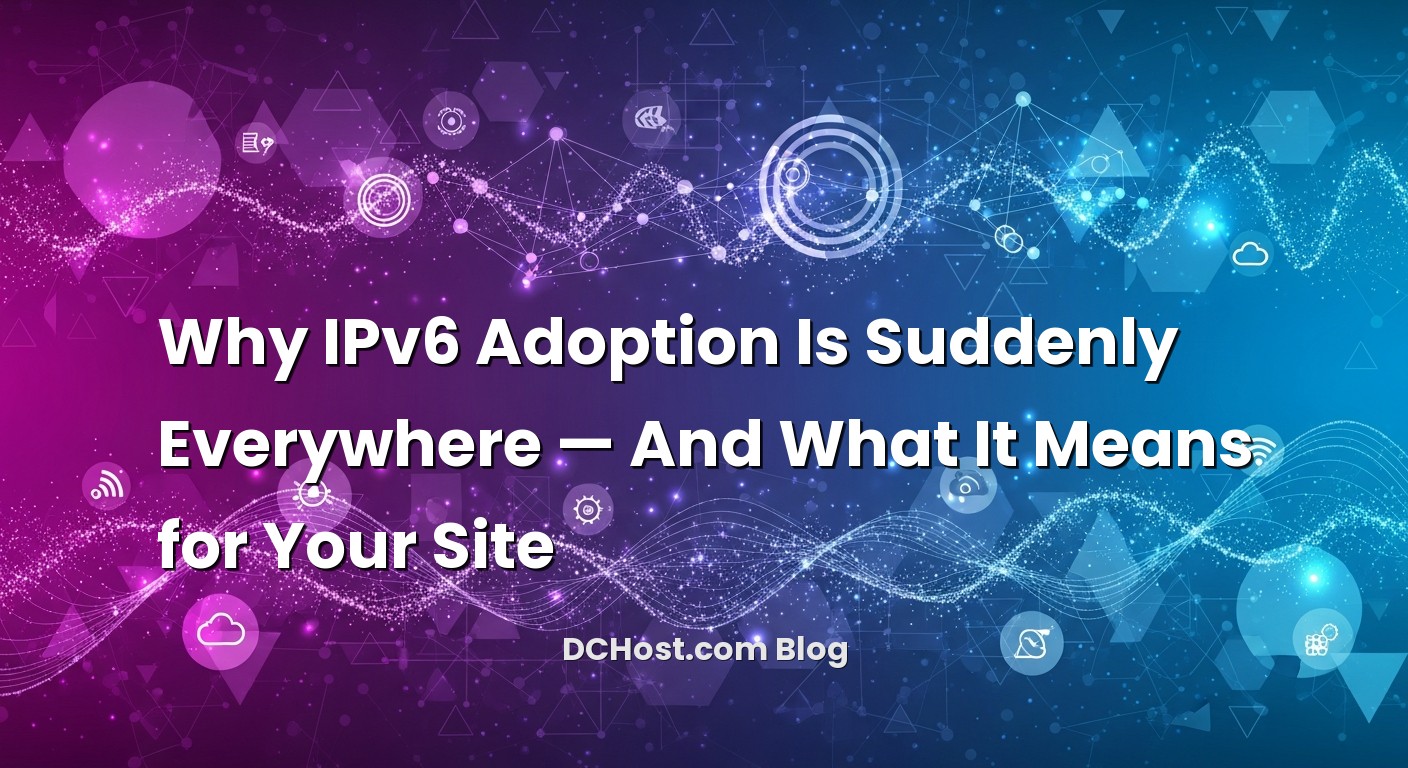So there I was, well past midnight, watching a graph climb on my dashboard like it had just discovered espresso. A client’s traffic line was splitting into two colors — the familiar IPv4, and a new, confident surge of IPv6. The funny thing? We hadn’t made any big announcement. No splashy release. We’d just quietly turned on dual-stack a week earlier, and now half of their mobile visitors were using IPv6 without even knowing it. That was the moment it really hit me: IPv6 isn’t a “someday” feature anymore. It’s here, it’s growing fast, and it’s quietly changing how the internet routes, speeds up, and scales.
Ever had that moment when you realize your site loads just a little faster on your phone than it does on your laptop? Or when you wonder why your access logs are suddenly full of addresses with colons instead of dots? That’s the IPv6 wave washing up on your shore. In this post, I want to walk you through why adoption is surging globally, what it practically changes for your website, the gotchas I’ve learned to watch for, and how to roll it out without stressing your team or your weekend. We’ll keep it friendly and real-world. No ivory tower jargon, no scary checklists you’ll never finish — just what actually works.
İçindekiler
- 1 The Quiet Tipping Point: Why IPv6 Is Surging Now
- 2 What IPv6 Actually Changes for Your Website (In Plain English)
- 3 A Real-World Rollout: The Week We Turned IPv6 On
- 4 Performance, But Make It Real
- 5 Security Myths, Debunked Gently
- 6 Your Coffee-Break Plan for Turning On IPv6
- 7 DNS, Certificates, and the Little Details That Matter
- 8 Monitoring, Analytics, and the “Wait, Why Is That IP So Long?” Moment
- 9 APIs, Microservices, and Real Infrastructure Life
- 10 Email, MX, and the Rest of the Neighborhood
- 11 What “Good” Looks Like After the Switch
- 12 The Business Angle: Why This Matters Beyond the Tech
- 13 Common Pitfalls (And How I Dodge Them)
- 14 If You’re Starting Today, Start Here
- 15 Wrap-Up: The Path Ahead Is Wide Open
The Quiet Tipping Point: Why IPv6 Is Surging Now
I remember when IPv6 felt like the gym membership we all knew we should use “one day.” Lots of intention, not much action. Then real life happened. Phones started preferring it. Big CDNs made it the default. Home routers got smarter. Hosting providers stopped treating it like an exotic feature. And suddenly the traffic graphs started tilting. You don’t need a whiteboard full of protocols to see it — the experience on the ground is simple: more users are arriving over IPv6 because the path is cleaner. No carrier-grade NAT, fewer middleboxes, fewer weird detours. Just a straight line from them to you.
Here’s the thing most people miss. IPv4 is like a city where every apartment is sublet three times and the elevator’s always busy. IPv6 is the new neighborhood down the street with wide sidewalks and actual parking. It doesn’t magically make your content better, but it makes the trip smoother. That’s why mobile networks love it. That’s why CDNs push it. And that’s why you’re seeing more of it whether you planned for it or not.
If you’re curious, you can always peek at Google’s live IPv6 adoption graph or explore APNIC’s measurement dashboard for a country-by-country feel. The exact numbers shift, but the direction is steady. Up and to the right.
What IPv6 Actually Changes for Your Website (In Plain English)
Let’s keep this practical. When you switch your site to dual-stack (meaning you offer both IPv4 and IPv6), visitors with IPv6-capable networks will use IPv6 automatically. No prompts. No pop-ups. Their devices just choose the best path. And when that path avoids the tangle of NATs, your first packet often gets through faster. It’s not a magic speed boost out of nowhere — it’s more like taking the side street you didn’t know existed and skipping three traffic lights.
From your side, the change starts in DNS. Today you probably have an A record pointing to your IPv4 address. Enabling IPv6 means adding an AAAA record pointing to your IPv6 address. If that sentence made you squint, I wrote a friendly refresher on A and AAAA records — plus the little DNS gotchas that trip us up. That’s the front door. Behind the scenes, your web server, load balancer, WAF, and CDN each need to understand and pass IPv6 traffic correctly. The good news? Most modern stacks do, right out of the box. The trick is making sure every piece in the chain says “yes.”
In my experience, three small touches make a big difference. First, ensure your TLS certificates are served over both v4 and v6 (your cert doesn’t care about IP versions; it just needs to be reachable). Second, confirm your CDN is listening on v6 — most are, but sometimes you have to flip a switch. Third, verify your origin firewall rules aren’t IPv4-only. I once spent an hour chasing a “random timeout” that turned out to be an overzealous v4-only rule quietly dropping v6 SYN packets. It happens. A quick audit saves your future self.
A Real-World Rollout: The Week We Turned IPv6 On
One of my favorite IPv6 stories comes from a retail client whose traffic spikes like clockwork on Friday evenings. We rolled out dual-stack early in the week, then sat back to watch. By the weekend rush, their mobile sessions were arriving over IPv6 in a big way. The customer journey didn’t change — product pages, cart, checkout — but the network path did. Fewer detours, cleaner handshakes. What impressed me wasn’t just the speed. It was the steadiness. When the rush came, IPv6 held up beautifully because it wasn’t fighting for space on congested NAT pools.
We did hit a small snag with a third-party API that only accepted IPv4 at the time. The fix was simple: keep the outbound traffic on IPv4 for that host while serving inbound traffic on both. Dual-stack isn’t all-or-nothing. Think of it like adding a new lane to your site’s expressway. You keep the old lane open while you test the new one. Over time, more drivers take the smoother lane. That flexibility matters when your site depends on a dozen services you don’t control.
What did we learn? Logs matter. Early on, their rate-limiting firewall grouped IPv6 users too broadly because the default rule wasn’t tuned for v6’s address patterns. We adjusted the threshold logic to be user-behavior aware, not just IP-pattern aware, and the false positives disappeared. Same story with analytics. Make sure your tooling understands and stores IPv6 addresses correctly. Truncating or mis-parsing them makes troubleshooting way harder than it needs to be.
Performance, But Make It Real
Performance is a game of inches. You don’t always see it on a stopwatch, but you feel it in bounce rates, in checkout friction, in the general “this site just feels snappy” vibe. IPv6 helps in subtle ways. I’ve seen shorter connection setup times on mobile networks where IPv6 is first-class. I’ve watched routes flatten when traffic avoids carrier NAT and hairpin turns. I’ve noticed fewer oddities with fragmented packets and less reliance on brittle middleboxes that don’t age well.
Will every user suddenly get a dramatic speed bump? No. But the path gets cleaner for a lot of them, and cleaner paths compound across the stack. Your CDN can reach more eyeballs natively over v6. Your origin doesn’t waste time with NAT translation. Your logs aren’t clogged with opaque shared addresses. It’s like switching from a shared dial-up line to your own fiber drop. Same internet, different feeling.
I also love what IPv6 does for future-proofing. When you’re planning a new microservice, a staging cluster, or a blue/green deploy, generous addressing stops being a constraint. You stop playing Tetris with RFC1918 space and start thinking clearly about topology. That clarity helps when you need to scale fast — fewer renumbering headaches, fewer “we’re out of addresses” moments right when you’re trying to launch.
Security Myths, Debunked Gently
Let’s talk security without the drama. I still hear two myths. First: “IPv6 is less secure.” Second: “If we enable IPv6, we’ll expose everything.” In practice, neither has to be true. IPv6 is just an addressing scheme. Your security posture depends on your policies, your tooling, and your discipline — the same as IPv4. The difference is that some teams forget to apply those same policies to v6, and that’s where trouble sneaks in.
Here’s what works for me. Treat IPv6 as a first-class citizen in your firewall, WAF, and rate limits. Mirror your IPv4 rulesets, then tune where IPv6 patterns differ. Keep ICMPv6 healthy (blocking it aggressively can break path MTU discovery and neighbor discovery in confusing ways). Make sure your log pipeline recognizes IPv6 formats end-to-end. And if you’re using geofencing or traffic shaping, confirm the providers you rely on are v6-aware so you don’t create blind spots.
One more practical note: don’t confuse “fewer NATs” with “less safety.” NAT was never a firewall; it just felt that way because it hid you behind shared addresses. With IPv6, your firewall becomes the real bouncer at the door — not the guy who simply lost the guest list. Default-deny inbound, allow what you intend, and you’re golden. Simpler, clearer, safer.
Your Coffee-Break Plan for Turning On IPv6
If we were sitting together sketching this on a napkin, I’d lay it out like this. First, check that your hosting provider and CDN both support IPv6 on your plan. Most do. Second, enable IPv6 on your origin server and verify your web server is listening on v6. I like to test locally with a quick curl to the v6 address or by resolving the AAAA record from a v6-enabled network. Third, add the AAAA record in DNS for your domain and any subdomains that serve content. Keep TTLs modest so you can roll back quickly if you spot anything odd.
Then, watch. Open your analytics and your logs and just observe for a day or two. If something breaks for a particular ISP or region, it usually surfaces quickly. This is also the moment to verify that your threat protection — WAF, bot filters, rate limiting — treats IPv6 traffic exactly like IPv4 traffic. The only “special” thing about v6 in this context is remembering to include it everywhere. Consistency wins.
From there, expand. Add IPv6 to your APIs, admin panels (with tight access controls, obviously), and static asset domains. If you’ve got a private staging environment, try it there first to build muscle memory. The goal isn’t perfection on day one. The goal is to make IPv6 so normal in your stack that you forget which protocol a visitor used to reach you — because both paths are smooth.
DNS, Certificates, and the Little Details That Matter
DNS is where most teams touch IPv6 first, and it’s also where the smallest mistakes cause the biggest headaches. AAAA records need to point to the correct v6 address of your origin or load balancer. If you’re using a CDN that terminates TLS, make sure the CDN edge has IPv6 enabled before you publish AAAA records to the world. And if you’re running any clever DNS-based routing, verify that the logic branches equally for v4 and v6 so users aren’t split into different experiences accidentally.
Certificates are thankfully boring here. Your TLS certificate doesn’t care about IPv4 versus IPv6 — it only cares about domain names. Whether you’re using a managed cert at your CDN or issuing with Let’s Encrypt on your servers, IPv6 won’t change the process. For wildcard setups and automated renewals, DNS-01 validation remains your friend. The key is simply making sure the cert is available wherever your traffic lands, on both protocols.
And a quick reminder if you’re dusting off DNS skills: if you’d like a gentle walkthrough of the record types you’ll bump into — especially A and AAAA — you can dive into DNS records explained like a friend, including the little gotchas that trip us up. Sometimes a five-minute refresher saves a two-hour rabbit hole.
Monitoring, Analytics, and the “Wait, Why Is That IP So Long?” Moment
The first time IPv6 really shows up in your day-to-day is usually in your logs. Instead of tidy dotted quads, you’ll see addresses with colons, sometimes shortened with double colons, and occasionally scoped. Don’t panic. Make sure your log collectors and dashboards fully support the IPv6 format. If you’re matching IPs with regex, widen those patterns. If you’re using IP-based allowlists, store v6 entries in the same source of truth you use for v4 so the two don’t drift out of sync.
I’ve noticed that analytics platforms handle v6 fairly well these days, but outbound webhooks or homegrown dashboards sometimes don’t. This is especially true where IP address fields were sized with IPv4 in mind. A quick schema check now saves you from mystery truncation later. And if you rely on IP reputation feeds, confirm your provider maintains robust IPv6 lists — or supplement with behavioral signals like request rate, path diversity, and user-agent analysis that work equally well across both protocols.
APIs, Microservices, and Real Infrastructure Life
Websites are the easy part. The interesting challenges show up in the spaces between services: your API gateway, your container network, the tunnel to your payment processor, the webhook to your CRM. Dual-stack those paths thoughtfully. For internal meshes, I like to plan addressing with generous prefixes so the network feels roomy for years. With IPv6, you can be deliberate about scoping and still have more than enough room to grow without renumbering.
If a third-party integration is IPv4-only, that’s fine. Keep that specific egress on v4 until they catch up, and make a note to revisit later. You don’t need every last integration on v6 to enjoy the benefits for your users. The public edge is where the gains are immediate: fewer NAT complications, smoother routes, and clearer telemetry. Meanwhile, your internal world gets cleaner too, simply because you’re not juggling overlapping private ranges or spending weekends planning the next address rework.
Email, MX, and the Rest of the Neighborhood
People often ask about email. In short, it’s similar but separate. If you want to receive mail over IPv6, you’ll publish AAAA records for the hostnames in your MX records and ensure your mail server listens on v6. Deliverability doesn’t hinge on IPv6 alone — authentication like SPF, DKIM, and DMARC still carry the day — but having v6 on your mail infrastructure gets you ready for peers that prefer it. If you send mail through a provider, check their stance on IPv6; many already support it, and they’ll guide you on any extra steps.
Other services follow the same pattern. Think of IPv6 as a capability you enable wherever clients connect. Databases? Usually internal, so not relevant to expose. Admin panels? Only if you need remote access — and then with tight ACLs. APIs? Absolutely, if they’re public. The rhythm is predictable once you’ve done it a couple of times. What looks like a big project from far away turns out to be a handful of careful switches, tested one by one, with rollbacks ready just in case.
What “Good” Looks Like After the Switch
In the weeks after enabling IPv6, here’s what I like to see. Your traffic mix shifts gently as more users arrive over v6, especially on mobile. Your error rates stay flat because your firewall rules and WAF policies were mirrored cleanly. Your analytics show healthy user behavior metrics — no weird drop-offs limited to specific ISPs or geographies. Your team gets comfortable reading and filtering IPv6 addresses in logs. And when someone new asks, “Did we turn on IPv6 yet?”, the answer is a calm, “Yes — and it’s been smooth.”
If something does feel off, it’s usually one of three things: a stray IPv4-only firewall rule at the edge, a CDN config that didn’t actually enable v6, or an upstream that refuses v6 on a specific hostname. Each of those has a straightforward fix. The important part is catching it quickly by watching your logs and listening for user reports right after launch. I like to schedule the switch early in the week, during normal business hours, so everyone’s fresh and available.
And for the curious, if you want broader context and practical guides on the adjacent pieces — caching, DNS behavior during migrations, or network failover — the folks at the Internet Society have a helpful set of resources; one door in is their IPv6 deployment overview. It’s a friendly perspective to complement your hands-on work.
The Business Angle: Why This Matters Beyond the Tech
Let’s zoom out for a second. IPv6 isn’t just an engineering checkbox; it’s customer experience and future capacity. When a site “just works” from anywhere — cleanly, predictably, and without the odd latency spikes we blame on the internet gremlins — users stick around. Searching product catalogs, compiling docs, watching demos, booking appointments — those microseconds add up to something that feels like polishing. You don’t need to sell your board on bitwise arguments. You can sell them on smoother traffic during marketing pushes and fewer brittle network edge cases during big releases.
There’s also a hiring angle I didn’t appreciate until I started mentoring newer engineers. Having IPv6 turned on in your estate turns it into a living lab. Folks get comfortable with address formats, with firewall rules that treat v6 as a peer, with observability that doesn’t flinch when the IPs get long. That comfort pays dividends the next time you need to re-architect something. It’s one less unknown, and one more skill the team carries confidently.
Common Pitfalls (And How I Dodge Them)
Most IPv6 “gotchas” are really just configuration blind spots. The first is forgetting to enable v6 on the CDN or load balancer while publishing AAAA records in DNS. Users try to connect, and the edge says, “Not listening.” Easy fix: enable at the edge first, publish DNS second. The second is writing firewall rules that only mention IPv4 objects. If your infrastructure tooling supports groups, create shared groups that always include both versions so your policies evolve together. The third is overlooking monitoring. I like to set up a couple of explicit IPv6 probes that request a small asset from the site, so I know the v6 path is healthy even if IPv4 looks fine.
Another one I’ve run into is misconfigured reverse proxies that don’t pass the true client IPv6 address upstream. If you rely on X-Forwarded-For or similar headers for rate limiting or logging, verify that your proxies add the IPv6 correctly and that your application parses comma-separated lists of addresses with both formats. Otherwise you’ll see “unknown” users all lumped together, and your protection logic won’t behave the way you expect.
If You’re Starting Today, Start Here
Here’s my favorite low-stress way to begin. Pick a low-traffic subdomain that still gets real users — something like a documentation site or a status page. Turn on IPv6 there, instrument it, and watch for a week. If you use a CDN, enable IPv6 at the edge, confirm the origin is reachable over v6, then publish the AAAA record. Once you’re comfortable, repeat the process on your main domain. By then, your team will feel at ease with the tooling and the logs, and the rest of your properties will follow without drama.
While you’re at it, spend ten minutes scanning your firewall and WAF rules for any v4-only assumptions. Replace one-off IP address references with named objects that can hold both versions. Check your analytics and logging pipeline for IPv6 support end-to-end. And if you maintain allowlists for admin access, update them to include your team’s v6 addresses too. It’s the same work you’d do for IPv4 — just with a longer, more expressive address format.
Wrap-Up: The Path Ahead Is Wide Open
When I think back to that midnight graph climbing the first time we turned on IPv6 for a major site, what strikes me isn’t the drama; it’s how uneventful it was. Traffic shifted. Errors stayed low. The internet felt a little more like the place it was meant to be — roomy, direct, and fast. And every rollout since has felt easier, mostly because the habits are now second nature. We enable IPv6, we mirror the policies, we watch the logs, and we move on with our day.
If you’ve been waiting for the perfect moment to flip the switch, this is as perfect as it gets. Start small, instrument well, and let your users take the smooth path without thinking about it. Add AAAA records with intention, keep your firewall honest, and treat IPv6 as the peer it is — not the experiment it used to be. If this sparked ideas or you hit a snag in your own rollout, shoot me a note. I’m always happy to trade stories and help you get to steady. Hope this was helpful! See you in the next post — and may your packets take the shortest path home.
Bonus rabbit hole if you’re in a learning mood: beyond the adoption graphs from Google and APNIC, I’ve found the Internet Society’s IPv6 resources to be a nice companion for context and real-world tips.





